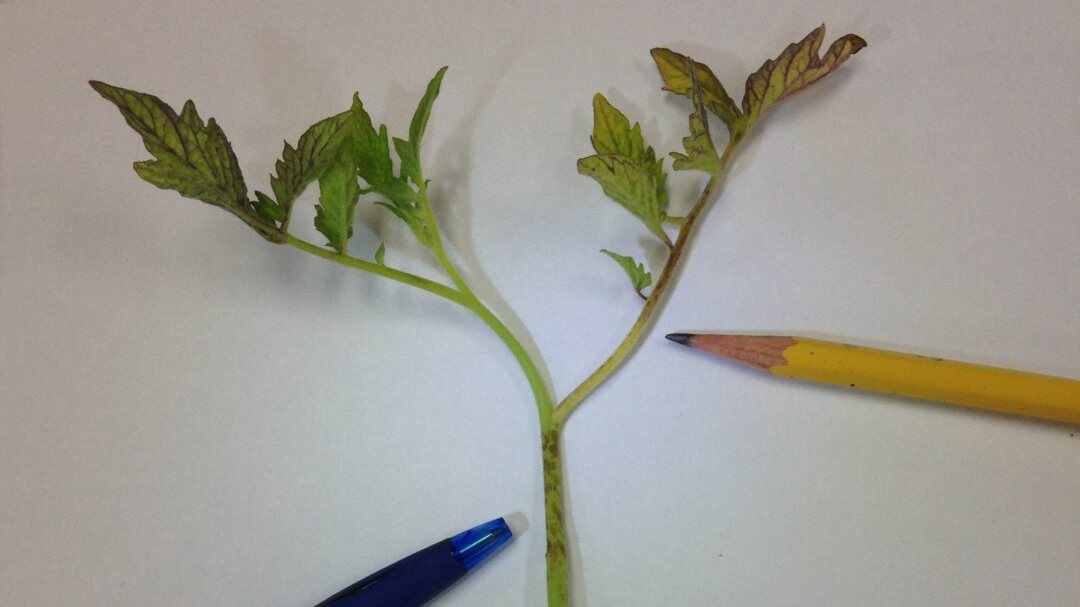In the last several years, vegetable transplant producers in California as well as all other major processing tomato growing regions in the world have noticed a disorder on processing tomato seedlings consisting of sunken lesions on the stems and leaves. The disorder only appeared on specific varieties of tomatoes and when tested for pathogens, the results come back negative. Several seed companies have done research on this issue and published the results in their brochures or informed customers about specific hybrid problems and ways to mitigate them. However, detailed information on the disorder, its origin and ways to manage it are not widely available yet.
We encourage seed producers to assist the vegetable transplant producers in mitigating our risk of loss when we grow these varieties. Many of our member nurseries have grown plants that exhibit this disorder, shipped them to the field and had them rejected by a wary customer. The nursery then bears the loss of dumping the plants and scrambles to find replacements. This can potentially disrupt schedules for farmers and canneries.
This report serves to present what is known about the disorder to date and to encourage seed companies, farmers, canneries and any other stakeholder to come forward and share with us any other data they might have on this issue with the goal of improving quality and efficiency in the processing tomato supply line. Please contact us to work together, perhaps by creating a committee of the various stakeholders’ representatives which could develop shared guidelines on the issue. We are anxious to see progress in a scientific and collaborative way.
Below is a summary of the research on Zebra Stem known to date.
In 2002, M.D. Ricker of Sunseeds Co. published the following announcement in “Phytopathology” Vol.92.
Association of zebra-stem symptoms on processing tomato with the Pto gene
Ricker, M.D.
Phytopathology 92(6 Suppl.): S69
2002
A previously unreported disorder of processing tomato has been observed in two breeding programs in the United States since the early 1990s. Symptoms include foliar necrosis, desiccation, and plant death, but the most common and striking symptom is an intricate pattern of stem necrosis. The disorder is consequently called “zebra-stem”. Symptoms have appeared in the greenhouse on plug transplants, and on mature plants grown in pots for hybridization. Zebra-stem has been found in the U.S., Canada and Australia. No pathogen or abiotic agent has been associated with this affliction. Incidence of zebra-stem has increased significantly since it was first observed, but so far is limited to experimental genotypes. All of the affected genotypes are thought to contain the Pto and Fen genes for bacterial speck resistance and fenthion susceptibility, respectively. An additional gene, which is apparently recessive and closely linked to Pto and Fen, is suggested as the cause of zebra-stem.
In 2014, the “Compendium of Tomato Diseases and Pests” is published by the American Phytopathological Society. In it Zebra Stem is mentioned without photos by J.W. Scott a researcher at the University of Florida.
Zebra Stem
Symptoms
Symptoms of zebra stem vary between tomato plants in the field versus those in the greenhouse. In the field, leaves become brown, necrotic, and desiccated, and the lower and middle portions of the stems become covered with light-colored lesions in a “bull’s eye” or zebra pattern. In the greenhouse, foliar lesions begin as small spots near the veins at the bases of expanding leaflets. The lesions coalesce and the leaflets desiccate, twist, and die. Stem lesions on greenhouse plants are black and sometimes coalesce into wide bands. Seedlings are often stunted but rarely die.
Cause
Zebra stem is associated with tomato cultivars that are homozygous for the Pto gene, which confers resistance to bacterial speck (caused by Psuedomonas syringae pv. tomato (Okabe, Young, Dye, & Wilkie). Zebra stem is likely caused by a gene linked to Pto.
Management
When growing cultivars with resistance to bacterial speck, heterozygous resistance for the Pto gene should be used.
(Prepared by J.W. Scott)
Recommendations from the VTNA
Seed Companies: New hybrid breeding programs should avoid the genetic make-up that leads to the zebra stem disorder, and older hybrids should be re-worked with the same objective.
Canneries: Avoid tomato cultivars that contain the genetic make up leading to the disorder where possible. When these cultivars must be used, warn nurseries and field growers of the risk.
Nurseries: Avoid sudden changes in temperature, relative humidity and light as much as possible. Keep susceptible cultivars well fed or ‘green and growing’. If a specific lot of plants does exhibit zebra stem, it will grow out with extra time and fertilization.
Field Growers: Be aware that when ordering zebra stem susceptible cultivars, the plants may not be ready on schedule if a burning event happens right before shipping. If there is no time to regrow a burnt lot, know that it has been proven many times by many different seed companies that even very ugly zebra stem plants will produce a normal crop after transplanting with normal care in the field.
Many thanks to Morningstar’s California Masterplant nursery for sharing their research with the VTNA.

